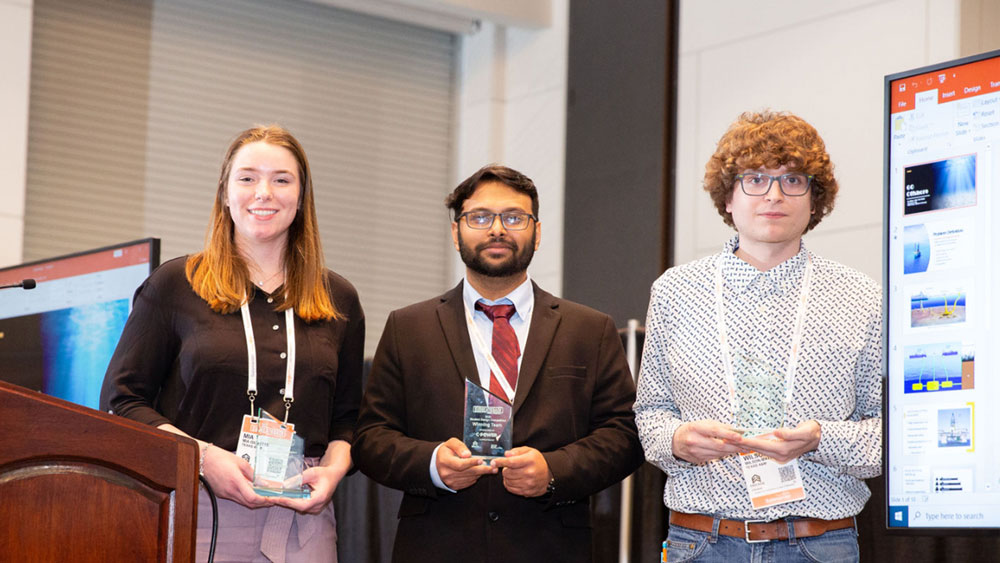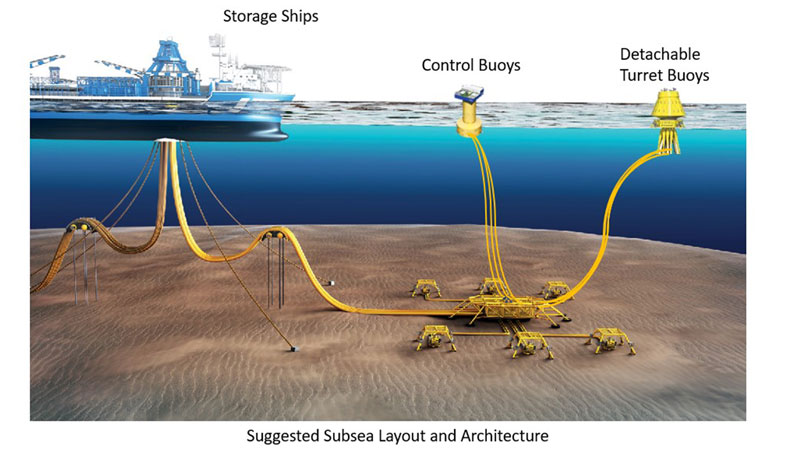
Texas A&M University student team members (from left to right) Mia Gillette, Mohammed Shafi, and Wilson Maya won first place for their proposed solution at the 2023 Subsea Tieback Forum. |
Image: Courtesy of Mohammed Shafi
A team of Texas A&M University students recently competed in the Subsea Tieback Forum (SSTB), an oil and gas industry competition for students, and won first place.
Subsea technology includes specialized equipment that operates in an extreme underwater marine environment to produce oil and gas safely. Each year, oil and gas industry members gather to host a design competition for engineering students worldwide. The challenge—present a solution for an offshore development design problem.
This year's participants were a mix of undergraduate and graduate students divided into teams of three to four. The teams were given an offshore development design challenge that would be the future of the subsea industry. After 10 hours of working together, each group presented their idea to a panel of industry judges who selected a winner based on the best solution and presentation. The team that took first place presented their solution to the conference.
The winning team, "Go Offshore," included three students from Texas A&M: Mohammed Shafi, a subsea engineering graduate student from the Department of Multidisciplinary Engineering; Mia Gillette, a first-year engineering student; and Wilson Maya, a senior marine technology engineering student at Texas A&M Galveston.
Subsea technology includes specialized equipment that operates in an extreme underwater marine environment to produce oil and gas safely. Each year, oil and gas industry members gather to host a design competition for engineering students worldwide. The challenge—present a solution for an offshore development design problem.
This year's participants were a mix of undergraduate and graduate students divided into teams of three to four. The teams were given an offshore development design challenge that would be the future of the subsea industry. After 10 hours of working together, each group presented their idea to a panel of industry judges who selected a winner based on the best solution and presentation. The team that took first place presented their solution to the conference.
The winning team, "Go Offshore," included three students from Texas A&M: Mohammed Shafi, a subsea engineering graduate student from the Department of Multidisciplinary Engineering; Mia Gillette, a first-year engineering student; and Wilson Maya, a senior marine technology engineering student at Texas A&M Galveston.

The team’s proposal shows turret buoys transporting the oil from an underwater subsea layout via risers. |
Image: Courtesy of Mohammed Shafi
The team proposed using turret buoys instead of a platform and a floating production storage and offloading (FPSO) vessel. The operator would only need to install the subsea layout and connect the risers to turret buoys on the surface.
"Our storage tankers would come and connect to the turret buoys to extract the oil and transport them to the operator's desired location, essentially creating an Uber for oil and gas," Shafi explained. "It's a huge benefit to operators because the solution doesn't require a platform, which takes 3-5 years to build and install. In addition to the time expense, building costs are often in the billions."
Their proposed solution would reduce the need for pipeline carbon emissions and provide the opportunity for unmanned platforms, thus increasing worker safety. Finally, the team's proposal would reduce the time required to begin production down to 2-4 years, far less than the typical 5-7 years.
"It was a great team bonding experience that challenged us to think out of the box and come up with a solution in hours, much like in the real world,” Shafi said. “I was thrilled to meet so many leaders from the subsea industry at the event. I recommend anyone who is up and coming in the industry to attend the yearly event. Lastly, I would like to thank all the judges, subject matter experts, and professors for their never-ending support."
Other subsea engineering graduate students who represented the multidisciplinary engineering department in the competition included: Isaiah Fernandes, Atharva Gaidhani, Hasaan Mazhar and Jeremiah Demehin. Ron Ledbetter, director of the Subsea Engineering Program and professor of practice, attended with his students.
"Our storage tankers would come and connect to the turret buoys to extract the oil and transport them to the operator's desired location, essentially creating an Uber for oil and gas," Shafi explained. "It's a huge benefit to operators because the solution doesn't require a platform, which takes 3-5 years to build and install. In addition to the time expense, building costs are often in the billions."
Their proposed solution would reduce the need for pipeline carbon emissions and provide the opportunity for unmanned platforms, thus increasing worker safety. Finally, the team's proposal would reduce the time required to begin production down to 2-4 years, far less than the typical 5-7 years.
"It was a great team bonding experience that challenged us to think out of the box and come up with a solution in hours, much like in the real world,” Shafi said. “I was thrilled to meet so many leaders from the subsea industry at the event. I recommend anyone who is up and coming in the industry to attend the yearly event. Lastly, I would like to thank all the judges, subject matter experts, and professors for their never-ending support."
Other subsea engineering graduate students who represented the multidisciplinary engineering department in the competition included: Isaiah Fernandes, Atharva Gaidhani, Hasaan Mazhar and Jeremiah Demehin. Ron Ledbetter, director of the Subsea Engineering Program and professor of practice, attended with his students.